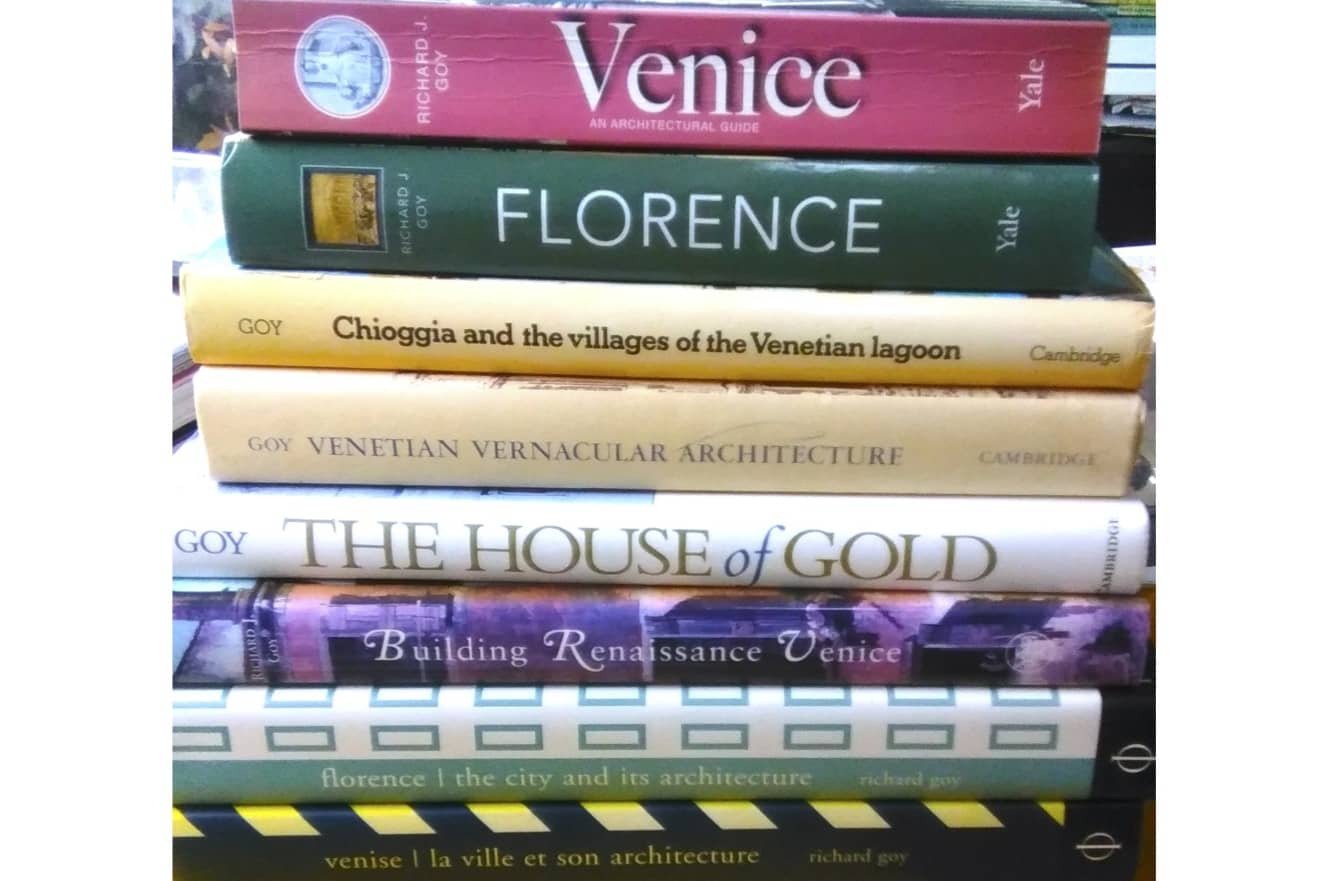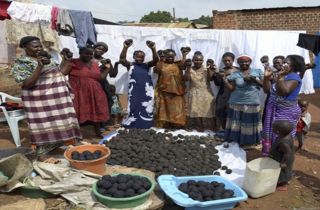
www.buildingsandcities.org/insights/commentaries/publishing-books-advice.html
Publishing Books: Advice for Authors

How might you choose an appropriate publisher and manage the processes involved in creating an academic book?
Architect and author Richard J Goy has published 8 books over 35+ years as well as numerous academic papers. Reflecting on his own experiences, he offers some advice to new authors planning to publish books about architecture and building.
My publishing history
My first three books were published by Cambridge University Press (CUP), the first in 1985. The next two were commissioned and were published by Phaidon; and the most recent three were published by Yale University Press. Not surprisingly, the two university presses had a broadly similar approach, whereas Phaidon, an up-market commercial publisher, had considerably more resource (and money) available to devote to the quality of the books themselves and to their marketing. They also sold considerably better, and one of them was also translated into French and German.
Choosing a publisher
If you have little or no knowledge of the publishing world, you could start by a perusal of the Writers' and Artists' Yearbook. Many publishers are fairly or highly specialised in the material that they publish. You should establish what kind of book you are aiming to publish and, in a broad sense, its likely readership. Is it purely academic, with a narrow, specialist appeal (you need to be honest here), or could it be defined as popular or 'semi-popular', i.e. with a significantly larger market?
The next logical step is to visit the websites of those publishers that look like potential 'contenders', to get a more focussed idea of the range of works that they publish, as well as issues like format and indicative retail prices. For example, the number of excellent publishers in the field of architecture and/or architectural history and related disciplines is actually pretty limited. And since nothing beats the real, tactile experience, it is worth a good browse in the appropriate section of large bookstores..
Some publishers have followed the apparently inevitable trend of acquiring smaller houses, such that they are effectively an 'umbrella' organization with a number of more specialised imprints under their wing. Routledge/Taylor and Francis is a good example. You should therefore check out carefully their various subsidiaries for a potentially suitable imprint.
What criteria did I use in choosing a publisher? My first published book was a fairly narrow, specialised work, based on my doctoral dissertation. (Doctoral dissertations are very rarely publishable in their original form, and almost always have to be tailored - or even largely re-written - to make them viable.) So it had to be an academic publisher, and at that time CUP had a guiding principle that they would publish almost any work provided it could be seen to have academic value and would increase knowledge. Their policy was therefore rather like the criteria for a university approving the subject matter of a research doctorate itself. CUP were extremely helpful and supportive, particularly as it was my first published book, although, like many other university presses, they were not particularly dynamic with marketing. My second book with CUP was effectively 'volume 2', as it was a closely linked subject, so it was natural to return to them for that, too. My editor was the same, and the process followed the first one very closely.
My third book with CUP was rather different, and they managed to fund a limited number of colour illustrations. This book was very widely and positively reviewed (even in the UK national press), and on the strength of that I was approached by Phaidon for a considerably larger, more ambitious work, aimed at a much broader readership, generously funded and fully illustrated. Phaidon also funded many of the photos, for which a specialist architectural photographer was commissioned. Phaidon were equally supportive editorially, almost to the same level of that of a university press. My second book with Phaidon followed a very similar process and was again effectively a companion volume.
How did I investigate how well the publisher would fulfil my requirements? Well, Phaidon have an excellent reputation for high quality books on all the visual arts, so I knew immediately that I would be in good hands. This is not necessarily the case with academic publishers, whose resources and production values are often less generous. CUP, for example, publish very few books on the visual arts, including architecture. Although they are of very good quality, they are also extremely expensive.
Other considerations
The length of time taken to be given a decision whether to publish or not is a factor, as well as the time taken to actually produce the book itself. Sadly, both of my academic publishers did not perform well here. University presses tend to have a fairly small staff in any one particular field and are often only resourced to publish a certain number of titles every year. This effectively results in a queue system. At Yale, for example, whose commissioning editor was absolutely excellent, I still had to wait for a full year after delivery of the completed manuscript before it entered into their programme for 'processing' and publishing. It can also take many months for them to decide whether to publish or not. Yale, for example, have to refer back to their editorial and commissioning board in New Haven, even though they have an office in London. You should be prepared, therefore, for some gentle (or not so gentle) pushing to try and get a decision from them. Once you are 'logged' into their system, the programme to publishing will take many months. It is extremely time-consuming, as you will be required to review copy edits, first proofs, page proofs, index and so on. Mentally allow yourself a great deal of time for this.
With regard to marketing, some publishers no longer send out hard copies for review. This makes the reviewer's position rather difficult, as it is extremely 'challenging' to review a PDF copy of the text, rather than the physical final product. It would be very useful to obtain confirmation that your publisher will indeed distribute hard copies.
Should you consider an agent?
There are clear advantages and disadvantages here. I have never published via an agent, and have always had direct close communication with the commissioning editor, which in itself has obvious advantages. Agents generally work on the basis of 'no commission: no fee', so there is no real financial disadvantage here. They do the negotiating and administrative work that you are probably ill equipped to undertake yourself. However, the number of agents covering your own particular field may well be fairly limited. Again, a perusal of the Writers' and Artists' Yearbook should give some idea as who might be appropriate. However… be aware that many agents have recently closed their lists to new authors, thus limiting the range even further.
Creating a book proposal
Most publishers have a fairly standard 'shopping list' of what they want to see before taking any decisions. You need to check their specific requirements carefully, and ONLY send what they want: usually an abstract, table of contents, sample chapter, approximate word count, indicative number of illustrations, and so on. They may also ask about the intended audience and similar (rival) books to inform their decision about the market for your book. This information allows the publisher to gauge the likely costs and potential print run and price. Academic publishers will almost always send some of this material out for anonymous peer review, usually to two or three other experts in the field. They will then send you their (anonymised) feedback, to which you need to respond carefully.
Design, layout, illustrations
All publishers have improved at this in recent years, partly with digital technology and the exceptionally high quality of photographic illustrations, although the cost of printing colour pictures is still a very big consideration. (Prepare to be disappointed if you have numerous lavish full colour photos in mind!) If you are providing your own photos, they must be high definition, fairly large files, preferably more than 2 or 2.5 MB each.
All three of my publishers were excellent in terms of support with design, etc. Yale also commissioned very helpful plans and maps, for example, although, as with all university presses, they usually expect you to provide all the photographs and other graphic material yourself. You will also need to clear any copyright issues. They will expect the full text and all accompanying scholarly apparatus: footnotes, bibliography, etc. The jacket design is produced by the publisher, although I have found that they are often open to suggestions/ proposals from the author.
The editing process
In my experience, in terms of copy editing, all three were very 'respectful' of the text as delivered, and equally conscientious at putting any proposed editorial changes to you for approval before they would go ahead, even with quite minor proposed changes to syntax etc. They may come up with more radical proposals for the organization of the text, and you should give these careful consideration before agreeing to them, or not. A happy compromise may be the best solution. The commissioning editor will maintain an overall high level interest in the book's progress, and will review key stages in the book's development, although all day to day matters will be dealt with by the dedicated 'hands on' editor.
Marketing
Most publishers will send you a quite detailed questionnaire regarding the likely readership, including publications that are likely to review the book. The questionnaire should be completed with considerable thought and care, as this is the publishers' best lead as to how to market it and to whom. To some extent, you will know the market better than they do, particularly if it is a specialised work. Again, as you would expect, the academic presses will undertake relatively low-key advertising, and it is a perennial, almost universal complaint among academic writers that 'publishers never really try hard enough' to market the book. Unfortunately, the author's power here is pretty limited.
Publishers such as Phaidon are much more dynamic in this respect, and may place adverts in a number of appropriate journals, some specialised, some more general. The Times Literary Supplement, New York Review of Books and London Review of Books are good examples of outlets that are 'semi-specialised 'in this field. Their circulation is relatively small but they are very influential. The publisher may well arrange a formal book launch at an appropriate venue, and arrange for prominent displays in major bookshop chains.
When choosing a publisher, you should also interrogate them on their proposals to advertise in electronic media, as well as the ubiquitous Amazon. As noted above, you should check whether they will issue review copies to all the people and/or bodies that you have recommended in your completed questionnaire, and hopefully others as well. You should ascertain what this distribution is.
Contract and money
Most publishers will have a standard form of contract. I have rarely had much success in amending this, other than one occasion when I managed to persuade them to increase the royalty percentage. Royalties are usually paid directly into your bank account, once or twice a year.
The retail price is also largely out of your hands. Academic books are expensive, as the print run will be small, sometimes very small, and it may only be bought by university libraries and similar institutions. You should probably think in terms of a few hundred copies here. Few will be bought by individuals. More popular books are likely to sell in the low to middling thousands. However, bear in mind that some books will remain in print for many years, so you may get a trickle of royalties (and sales) over a long period. Digital and 'on demand' reprints are now widely used, and also help to keep the book 'alive'.
Foreign book rights
I have very little experience here, as only one of my books was translated (into French and German) and sold abroad. The layout, appearance etc. were exactly as the English original. Translation costs are borne by the original publisher, and in my case at least, the royalties were slightly higher than the original contract, since the foreign editions were undertaken on the basis of an agreed minimum print run/sales.
Latest Peer-Reviewed Journal Content
Youth engagement in urban living labs: tools, methods and pedagogies
N Charalambous, C Panayi, C Mady, T Augustinčić & D Berc
Co-creating urban transformation: a stakeholder analysis for Germany’s heat transition
P Heger, C Bieber, M Hendawy & A Shooshtari
Placemaking living lab: creating resilient social and spatial infrastructures
M Dodd, N Madabhushi & R Lees
Church pipe organs: historical tuning records as indoor environmental evidence
B Bingley, A Knight & Y Xing
A framework for 1.5°C-aligned GHG budgets in architecture
G Betti, I Spaar, D Bachmann, A Jerosch-Herold, E Kühner, R Yang, K Avhad & S Sinning
Net zero retrofit of the building stock [editorial]
D Godoy-Shimizu & P Steadman
Co-learning in living labs: nurturing civic agency and resilience
A Belfield
The importance of multi-roles and code-switching in living labs
H Noller & A Tarik
Researchers’ shifting roles in living labs for knowledge co-production
C-C Dobre & G Faldi
Increasing civic resilience in urban living labs: city authorities’ roles
E Alatalo, M Laine & M Kyrönviita
Co-curation as civic practice in community engagement
Z Li, M Sunikka-Blank, R Purohit & F Samuel
Preserving buildings: emission reductions from circular economy strategies in Austria
N Alaux, V Kulmer, J Vogel & A Passer
Urban living labs: relationality between institutions and local circularity
P Palo, M Adelfio, J Lundin & E Brandão
Living labs: epistemic modelling, temporariness and land value
J Clossick, T Khonsari & U Steven
Co-creating interventions to prevent mosquito-borne disease transmission in hospitals
O Sloan Wood, E Lupenza, D M Agnello, J B Knudsen, M Msellem, K L Schiøler & F Saleh
Circularity at the neighbourhood scale: co-creative living lab lessons
J Honsa, A Versele, T Van de Kerckhove & C Piccardo
Positive energy districts and energy communities: how living labs create value
E Malakhatka, O Shafqat, A Sandoff & L Thuvander
Built environment governance and professionalism: the end of laissez-faire (again)
S Foxell
Co-creating justice in housing energy transitions through energy living labs
D Ricci, C Leiwakabessy, S van Wieringen, P de Koning & T Konstantinou
HVAC characterisation of existing Canadian buildings for decarbonisation retrofit identification
J Adebisi & J J McArthur
Simulation and the building performance gap [editorial]
M Donn
Developing criteria for effective building-sector commitments in nationally determined contributions
P Graham, K McFarlane & M Taheri
Join Our Community

The most important part of any journal is our people – readers, authors, reviewers, editorial board members and editors. You are cordially invited to join our community by joining our mailing list. We send out occasional emails about the journal – calls for papers, special issues, events and more.
We will not share your email with third parties. Read more



Latest Commentaries
COP30 Report
Matti Kuittinen (Aalto University) reflects on his experience of attending the 2025 UN Conference of the Parties in Belém, Brazil. The roadmaps and commitments failed to deliver the objectives of the 2025 Paris Agreement. However, 2 countries - Japan and Senegal - announced they are creating roadmaps to decarbonise their buildings. An international group of government ministers put housing on the agenda - specifying the need for reduced carbon and energy use along with affordability, quality and climate resilience.
Building-Related Research: New Context, New Challenges
Raymond J. Cole (University of British Columbia) reflects on the key challenges raised in the 34 commissioned essays for Buildings & Cities 5th anniversary. Not only are key research issues identified, but the consequences of changing contexts for conducting research and tailoring its influence on society are highlighted as key areas of action.